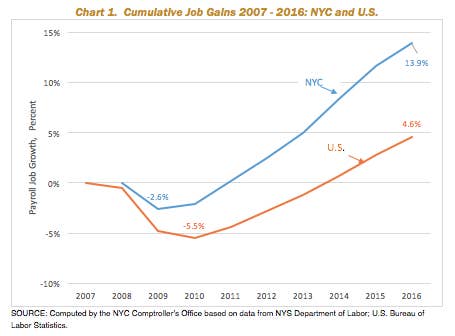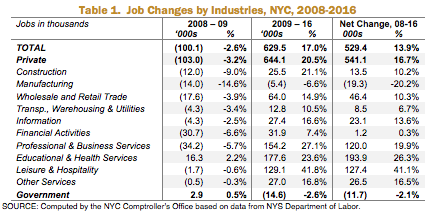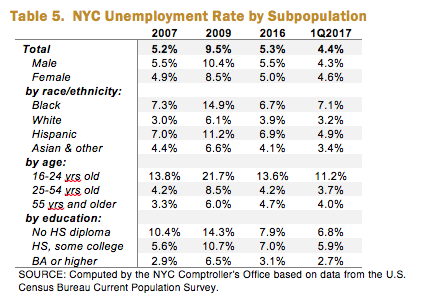The New York City workforce has rebounded from the Great Recession faster than the rest of the country, but much of that growth has been in low-wage sectors, according to data from the city's comptroller.
"New York City, compared to the rest of the nation, fared reasonably well: the recession hit later and was shallower in terms of job losses, and the expansion has been more robust," the report says.
Overall employment has grown 14% from 2007 to 2016 in New York City, compared to 4.6% nationwide, with New York City adding 529,400 new jobs net after losing 100,000 in the recession.
The analysis, looking at federal and state employment data from 2009 to 2016, shows a cratering of high-wage jobs in the early years of the downturn, as the financial crisis took out entire investment banks and severely wounded others.

Almost 65,000 jobs in finance and professional services were lost between 2008 and 2009, the two sectors with the biggest total downturns. Since 2009, the number of finance jobs has basically stayed flat, while business and professional services have grown 20%.
New York City's manufacturing sector, while not large compared to behemoths like retail and hospitality, had the biggest downturn since the end of the recession, losing 19,000 of its workers, a 20% drop. Jobs in leisure and hospitality, and in education and health services, by contrast, expanded 41% and 26% respectively, employing 127,000 and 193,000 more people net from 2008 to 2016.
"Although job gains during the recovery have exceeded recession losses across the board, lower-paying sectors gained the greatest number of jobs from 2009 to 2016, adding 359,000 or about 56% of all private-sector job gains, followed by medium-wage jobs (21.5%), and high-wage jobs (17.1%) As a result, there has been a continued shift toward lower-paying jobs," the report says.

The data may also show a large increase in so-called gig economy jobs in the city, the Office of the Comptroller said. The number of self-employed people who work in "transportation, warehousing, and utilities" has grown by 8,500, or 7%. Self-employment in the “other services” and information sectors, which may also include part-time workers managed through apps by their customers, has respectively grown by 3% and 7%, or 3,500 and 13,000. About 11% of New York City residents are self-employed.
While New York City has managed the tumultuous economy of the last decade better than the country as a whole, many new jobs have offered relatively low wages, and not all groups have equally benefitted from the expansion.

Much like the rest of the country, the unemployment rate for black people is substantially higher than the city's overall unemployment rate — at 7.1% compared to 3.2% for white people. The unemployment rate for black people peaked at 14.9% in 2009. On the other hand, the "Asian and other" unemployment rate has fluctuated much less throughout the economic cycle, peaking at only 6.6% in 2009 and settling at 3.4% in the beginning of 2017.
"We obviously have big challenges — an affordability crisis, rising income inequality, and more," Comptroller Scott Stringer said in a statement accompanying the report. "But this in-depth look demonstrates that New York City is thriving in a way that other cities and states aren’t."
